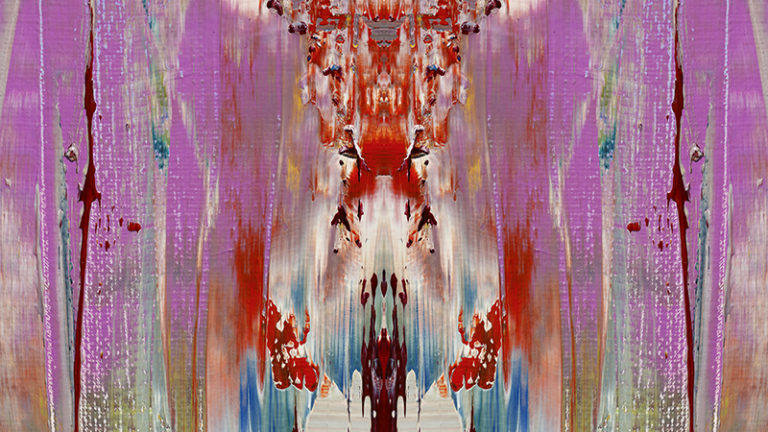Joy, transformation, transcendence—all lofty goals of early abstract expressionism—are exalted in the present tense at The Shed in the world premiere collaboration of three major 20th-century artists, now in their sunset years.
This stellar exhibition is marked by the long history of painted depictions of the divine and at the same time informed by flash mobs, minimalism, Eastern Orthodox Christianity, the brutal modern history of Eastern Europe, and not least, Gerhard Richter’s signature experimentation in layering and tooling paint. Haunting musical works by Steve Reich and Arvo Pärt—revolutionary composers known to set spines tingling—and the patient talent of filmmaker Corinna Belz (dir. Gerhard Richter Painting, 2012), who translates the artist’s methods into the video medium, complete this participatory hybrid techno-performance, which deprives the observer’s position of neutrality.
The collaboration takes place over 60 minutes in two rooms: a vestibule gallery featuring a tear-jerking and haunting “alleluia” song cycle by Pärt (Drei Hirtenkinder aus Fátima [Three Little Shepherds of Fátima], 2014) that erupts a cappella from singers scattered among the unwitting audience, and a second, larger gallery with Richter and Belz’ immersive floor-to-ceiling video accompanied by a live orchestra playing a world premiere by Reich, written specifically for Richter’s video—but based on Richter having listened to Reich’s structural experimentation over decades to inform his painting.
While the viewer’s experience is linear, in its totality Reich Richter Pärt is a cycle, repeating hour after hour, day after day, for two straight months (alternating performers from Ensemble Signal, the International Contemporary Ensemble, the Choir of Trinity Wall Street, and the Brooklyn Youth Chorus). This linear/circular dichotomy is the epicenter of the work and entwines the audience within an existential contradiction endemic to the human life cycle, which we experience both as creators and observers to phenomena of beauty.
In the first gallery, Richter’s columnar digital prints, inspired by his algorithmic work/book Patterns (2012), applied to the 15-foot-high walls as architectural elements, reference Richter’s fascination with stained glass. The metaphor of a house of worship extends to large, wall-hung tapestries based, like the video in the next room, on his 2016 abstract painting 946-3. Made through the algorithmic splitting, doubling and folding of segments of Richter’s paintings, these patterns are like Rorschach tests or marble, once moving, now static objects of contemplation.
Yet they are unsettling. Rothko’s Chapel (completed after the artist’s suicide in 1970) comes to mind as an after-affect of the exhibition, when the Richter/Belz video of the second gallery has played out. Seemingly an apex to Richter’s production, it provides a way to conceptualize his life’s work in light of his advancing age but without his hand or presence. Multitudinous “color bars” bracket the Richter/Belz video, and as the painting’s abstract color imagery is woven and animated through cutting and layering, its mesmerizing, vibrational energy communicates spiritual yearning while Reich’s accompanying ode-to-joy memorializes Richter, as if postmortem. The climactic resolution of the video’s ornate patterning back into strata of color recalls a speed Paul Virilio might refer to as the logical perception of war, but also suggests the artist foreseeing his own endurance after death. We recall Belz’ interview when Richter reveals he never again saw his parents after leaving East Germany to become an artist, his past like a shadow in the many paintings and images he has destroyed on this path to envision a joyful, transcendent future—bringing his audience to awareness: this awaits us all.




















0 Comments